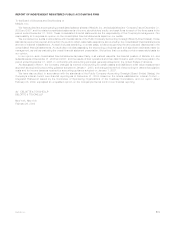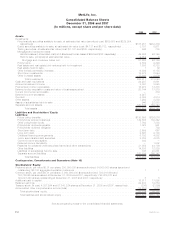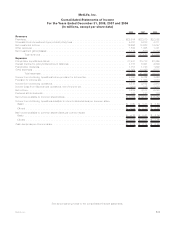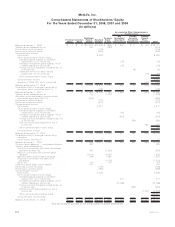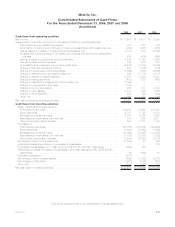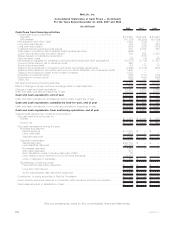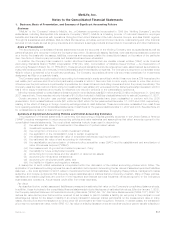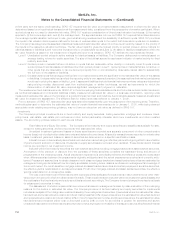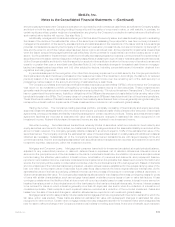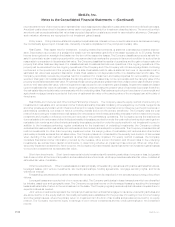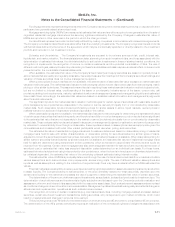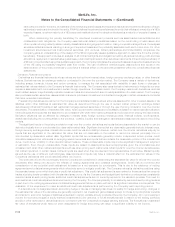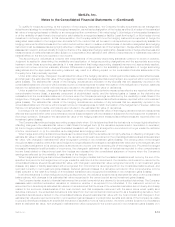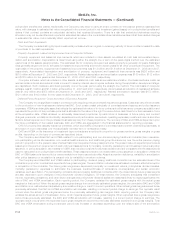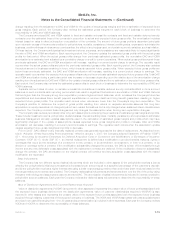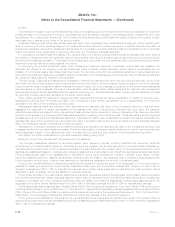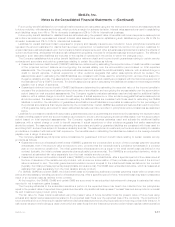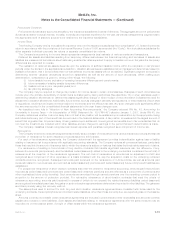MetLife 2008 Annual Report Download - page 133
Download and view the complete annual report
Please find page 133 of the 2008 MetLife annual report below. You can navigate through the pages in the report by either clicking on the pages listed below, or by using the keyword search tool below to find specific information within the annual report.recorded at the lower of amortized cost or estimated fair value less expected disposition costs determined on an individual loan basis.
Amortized cost is determined in the same manner as for mortgage loans held-for-investment described above. The amount by which
amortized cost exceeds estimated fair value less expected disposition costs is accounted for as a valuation allowance. Changes in
such valuation allowance are recognized in net investment gains (losses).
Policy Loans. Policy loans are stated at unpaid principal balances. Interest income on such loans is recorded as earned using
the contractually agreed upon interest rate. Generally, interest is capitalized on the policy’s anniversary date.
Real Estate. Real estate held-for-investment, including related improvements, is stated at cost less accumulated depreci-
ation. Depreciation is provided on a straight-line basis over the estimatedusefullifeoftheasset(typically20to55years).Rental
income is recognized on a straight-line basis over the term of the respective leases. The Company classifies a property as held-for-
sale if it commits to a plan to sell a property within one year and actively markets the property in its current condition for a price that is
reasonable in comparison to its estimated fair value. The Company classifiestheresultsofoperationsandthegainorlossonsaleofa
property that either has been disposed of or classified as held-for-sale as discontinued operations, if the ongoing operations of the
property will be eliminated from the ongoing operations of the Company and if the Company will not have any significant continuing
involvement in the operations of the property after the sale. Real estate held-for-sale is stated at the lower of depreciated cost or
estimated fair value less expected disposition costs. Real estate is not depreciated while it is classified as held-for-sale. The
Company periodically reviews its properties held-for-investment for impairment and tests properties for recoverability whenever
events or changes in circumstances indicate the carrying amount of the asset may not be recoverable and the carrying value of the
property exceeds its estimated fair value. Properties whose carrying values are greater than their undiscounted cash flows are written
down to their estimated fair value, with the impairment loss included in net investment gains (losses). Impairment losses are based
upon the estimated fair value of real estate, which is generally computed using the present value of expected future cash flows from
the real estate discounted at a rate commensurate with the underlying risks. Real estate acquired upon foreclosure of commercial and
agricultural mortgage loans is recorded at the lower of estimated fair value or the carrying value of the mortgage loan at the date of
foreclosure.
Real Estate Joint Ventures and Other Limited Partnership Interests. The Company uses the equity method of accounting for
investments in real estate joint ventures and other limited partnership interests consisting of leveraged buy-out funds, hedge funds
and other private equity funds in which it has more than a minor equity interest or more than a minor influence over the joint ventures or
partnership’s operations, but does not have a controlling interest and is not the primary beneficiary. The Company uses the cost
method of accounting for investments in real estate joint ventures and other limited partnership interests in which it has a minor equity
investment and virtually no influence over the joint ventures or the partnership’s operations. The Company reports the distributions
from real estate joint ventures and other limited partnership interests accounted for under the cost method and equity in earnings from
real estate joint ventures and other limited partnership interests accounted for under the equity method in net investment income. In
addition to the investees performing regular evaluations for the impairment of underlying investments, the Company routinely
evaluates its investments in real estate joint ventures and other limited partnerships for impairments. The Company considers its cost
method investments for other-than-temporary impairment when the carrying value of real estate joint ventures and other limited
partnership interests exceeds the net asset value. The Company takes into consideration the severity and duration of this excess
when deciding if the cost method investment is other-than-temporarily impaired. For equity method investees, the Company
considers financial and other information provided by the investee, other known information and inherent risks in the underlying
investments, as well as future capital commitments, in determining whether an impairment has occurred. When an other-than-
temporary impairment is deemed to have occurred, the Company records a realized capital loss within net investment gains (losses)
to record the investment at its estimated fair value.
Short-term Investments. Short-term investments include investments with remaining maturities of one year or less, but greater
than three months, at the time of acquisition and are stated at amortized cost, which approximates estimated fair value, or stated at
estimated fair value, if available.
Other Invested Assets. Other invested assets consist principally of freestanding derivatives with positive estimated fair values,
leveraged leases, joint venture investments, tax credit partnerships, funding agreements, mortgage servicing rights, and funds
withheld at interest.
Freestanding derivatives with positive estimated fair values are more fully described in the derivatives accounting policy which
follows.
Leveraged leases are recorded net of non-recourse debt. The Company participates in lease transactions which are diversified
by industry, asset type and geographic area. The Company recognizes income on the leveraged leases by applying the leveraged
lease’s estimated rate of return to the net investment in the lease. The Company regularly reviews residual values and impairs them to
expected values as needed.
Joint venture investments represent the Company’s investments in entities that engage in insurance underwriting activities and
are accounted for on the equity method. Tax credit partnerships are established for the purpose of investing in low-income housing
and other social causes, where the primary return on investment is in the form of tax credits and are also accounted for on equity
method. The Company reports the equity in earnings of joint venture investments and tax credit partnerships in net investment
income.
F-10 MetLife, Inc.
MetLife, Inc.
Notes to the Consolidated Financial Statements — (Continued)



